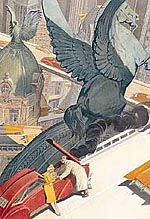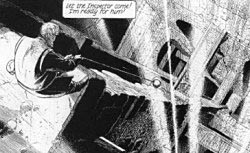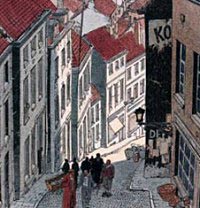>> The Friday Review: Pubo
>> The Friday Review: Get Your War On
More...

They do things differently over on the continent - particularly so in the field of comics. It's difficult to imagine a series like artist François Schuiten and writer Benoît Peeters's LES CITES OBSCURES (THE OBSCURE CITIES) getting off the ground at all in the UK or the US, let alone achieving widespread acclaim and success almost from the go and then sustaining it for the next twenty years.
Begun in 1982 with the serialisation of 'Les Murailles de Samaris' ('The Walls of Samaris') in the French magazine A Suivre, THE OBSCURE CITIES spans twelve volumes, with a new one expected in the near future. Spin-offs from the series include oddities such as an album collecting the front pages of newspapers published in the 'Obscure' world and even a Michelin style green guide to the cities. The series' website, urbicande.be is a huge, sprawling thing of beauty in itself, deliberately mysterious and designed to echo the character of the series.
Meanwhile, Schuiten and Peeters have both been singled out for some of European comics' most prestigious awards. Off the back of their work in comics, the two creators have designed exhibitions and shows and found worked in cinema. Images from the series have even been used to decorate subway stations in Brussels and Paris.
Naturally, the number of people outside of mainland Europe who know any of this is distressingly small.
The premise behind THE OBSCURE CITIES is that while the stories in each volume of the series are self-contained, each is set in the same shared universe - a parallel retro SF/Fantasy world owing much to the imaginings of Jules Verne and various European architects both classical and modern.
 The world of THE OBSCURE CITIES can be reached from our own through certain doorways, and later volumes in the series deal with the strange relationship between the 'real' world and its fantastical, fictional counterpart. Various historical figures from our world - both fictional and non-fictional - are established as having visited or somehow influenced the development of the Obscure world in the past.
The world of THE OBSCURE CITIES can be reached from our own through certain doorways, and later volumes in the series deal with the strange relationship between the 'real' world and its fantastical, fictional counterpart. Various historical figures from our world - both fictional and non-fictional - are established as having visited or somehow influenced the development of the Obscure world in the past.
Whilst the universe of THE OBSCURE CITIES is very different from our own, it is also clear that the cities and lands portrayed in the series are supposed to be a distant echo of those that exist in the real world (or is it the other way round?).
Schuiten and Peeters' vision is clearly influenced by a number of different literary sources, including the work of Borges and Kafka, but the most obvious comparison is with the work of Italo Calvino; in particular, his 1972 novel INVISIBLE CITIES. Calvino's novel details a series of conversations between Kublai Kahn and Marco Polo in which the explorer describes a succession of fantastic cities he has visited. In these descriptions, however, Calvino is writing about just the one city; Venice.
Just as each of Calvino's cities embodies a certain element of Venetian society, the Obscure Cities are aspects of real world cities writ large. Like Calvino, Schuiten and Peeters use the surreal and the fantastic to explore the psychological and sensual aspects of the urban experience.
Over the years, THE OBSCURE CITIES series has become hugely popular in Europe, attracting an enthusiastic and devoted audience, many of whom have ended up contributing to the series in some way themselves.
In 1985, a fan produced a companion piece to the second OBSCURE CITIES story entitled LE MYSTÈRE D'URBICANDE (THE MYSTERY OF URBICANDE). Schuiten was so impressed by it that he agreed to provide illustrations for the slim booklet, using the pseudonym 'Robert Louis Marie de la Barque'. Since then, Schuiten and Peeters have actively sought out ideas and suggestions from their fans, working the best of them into the series, and even introducing several contributors as fictional characters.
 This incestuous mingling of fact and fiction is more than just a gimmick - it reflects an important and central theme of the entire series, in which the question of what is real and what is not is returned to time and again.
This incestuous mingling of fact and fiction is more than just a gimmick - it reflects an important and central theme of the entire series, in which the question of what is real and what is not is returned to time and again.
Unfortunately, whilst widely read in Europe, only a handful of the OBSCURE CITIES books have seen print in English. HEAVY METAL and CHEVAL NOIR have both serialised Schuiten and Peeters' work in the past, although the translation has always left something to be desired (a shame, as Peeters' text is replete with self-referential in-jokes and subtle architectural and literary references). Of late, however, New York-based publisher NBM has begun to publish the series in collected format under the CITIES OF THE FANTASTIC banner - although so far only four volumes have been released.
The first of these is 'The Great Walls of Samaris' - also the very first OBSCURE CITIES story. 'Walls of Samaris' begins in the fabulous Art Nouveau city of Xhystos, and follows young army officer Franz Bauer as he travels to the distant protectorate of Samaris on a fact-finding mission. (People have a habit of never returning from Samaris, and the ruling council of Xhystos is growing increasingly suspicious.)
After a long and arduous journey he arrives in Samaris to find it a beautiful, yet strange and haunted place, composed of narrow, winding streets and almost uniformly windowless buildings. Streets and alleys seem to appear and disappear almost before his eyes, and Bauer begins to suspect that Samaris conceals a sinister secret. Eventually, he is proved correct.
The 1983 'sequel', 'Fever in Urbicand' (a more accurate translation would be 'The Fever of Urbicande'), is the second NBM release. Urbicand is introduced as a city of two halves - the river that runs through it functions not just as a physical divide, but as a social one as well. On the South Bank, the aristocracy of the city lead a wealthy and salubrious existence, whilst on the North Bank the proletariat live in relative poverty. Two bridges connect the shores, and traffic between them is heavily regulated (which is the mechanism through which the social order is maintained).
 The story's protagonist is the city's Urbatect, Eugen Robick, who has been sent a strange cube found at one of his building sites. The cube proceeds to attach itself to his desk and grow - evolving into a 'network' that, while tangible, passes harmlessly through solid objects. As it spreads across the city, the North and South shores are connected in hundreds of different places, ending the restrictions on traffic. The book deals with the massive social upheavals the network subsequently causes, and how Robick becomes caught up in them.
The story's protagonist is the city's Urbatect, Eugen Robick, who has been sent a strange cube found at one of his building sites. The cube proceeds to attach itself to his desk and grow - evolving into a 'network' that, while tangible, passes harmlessly through solid objects. As it spreads across the city, the North and South shores are connected in hundreds of different places, ending the restrictions on traffic. The book deals with the massive social upheavals the network subsequently causes, and how Robick becomes caught up in them.
The next volume, 'The Tower', tells the story of Giovanni Batista - a caretaker who lives and works inside a vast tower; one so large that he could never hope to see all of it in his lifetime. (The tower itself is clearly modelled on representations of the Tower of Babel.)
Giovanni is responsible for maintaining the (relatively) small area of the building in which he lives, but one day decides that the loneliness is too much and abandons his sector in order to find out what is going on elsewhere. Eventually, he comes across a part of the building inhabited by the academic and collector Elias Aureolus Palingenius, who lives with his young ward Milena amid a vast collection of paintings and books about the tower. Elias has grown concerned that something bad is happening to their home, and so Giovanni and Milena elect to make the long, hard journey to the top floor in order to find out what.
The most ambitious work out of the four volumes here, however, is 'Brüsel' - also the most recent CITIES OF THE FANTASTIC release from NBM. Brüsel is, as you may already have guessed, a thinly veiled Brussels - Schuiten's home town. Mirroring the development of the real-world city over the course of the last fifty years or so, the book follows the transformation of Brüsel from quaint, provincial town to bustling metropolitan city. Told mainly from the perspective of flower shop owner Constant Abeels, Brüsel nevertheless boasts a sizeable cast of characters and differing viewpoints. A complex and visually stunning work, Brüsel is nevertheless quite accessible and extremely entertaining.
THE OBSCURE CITIES series is something special, even by the high standards of the Franco-Belgian school of sequential art; a unique and magical series that skilfully blends the real and unreal. Rich in atmosphere and detail, the Obscure world conveys a sense of tangibility far surpassing that of other fantastical universes; its cities linger on in your head long after you've closed the book on their physical, real world existence. In the course of the series, Schuiten and Peeters have succeeded in creating a wondrous make-believe world that doesn't so much convince you as seduce you into believing it exists.
Like I said, they do things differently over there.

This article is Ideological Freeware. The author grants permission for its reproduction and redistribution by private individuals on condition that the author and source of the article are clearly shown, no charge is made, and the whole article is reproduced intact, including this notice.


